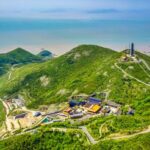Hengshan Island, one of the 12 islands of the Qiangjiao Archipelago, is an important part of the developing Ninghai Bay tourist and holiday resort area. The island runs from north to south, measuring 0.76 kilometers in length and 0.23 kilometers in width, with the highest point at an elevation of 51 meters. Regardless of the angle from which the island is viewed, it appears horizontal, resembling the Chinese character for ‘mountain’, hence the name. On the island, there is a temple called Zhenfu Temple, which was originally divided into two halls, with a foundation dating back to the Ming Dynasty and beam-column structures from the Qing Dynasty, known as ‘Little Putuo’. Devotees from the regions of Fenghua, Ningbo, and Ninghai continuously visit this sacred place. The island is covered with lush forests and tall bamboos, creating a serene and tranquil environment. The rocks around the island, shaped by years of wave erosion, form a variety of fascinating and alluring shapes. A visit here could make one feel like a ‘Fairy of Penglai’. Other attractions include Punan Zen Temple and the former site of the Provincial Fisheries School. This is an ancient and mysterious island. As early as the Han Dynasty, Emperor Wu established a pavilion here due to its strategic maritime location. In the Northern Song Dynasty, Lin Bu, who was known for his companionship with plum blossoms and cranes, took an interest in this place and built the Tai Chi Palace in the shape of the Bagua symbol at Sigu Ping. By the Ming Dynasty, the area became known as ‘Shenlou Gate’ due to the appearance of mirages, and the entire coastal region was named ‘Shen Sea’. At this time, a story about Guanyin saving people from distress spread among the people, and the Zhenfu Temple, which enshrines Guanyin, was erected on Hengshan Island, and the name ‘Little Putuo’ spread far and wide. Since the Ming Dynasty, logging has been banned, and the island is now filled with ancient towering trees, including a mulberry tree and a hibiscus tree that are over 700 years old. Today, Qiangjiao has built a 3,000-ton-class wharf, which is a natural good harbor and a seafood base for Ningbo City. However, the remains of pavilions and forts, ancient buildings from the Ming and Qing Dynasties, Sigu Ping Taoist temple, and the Little Putuo temple complex are still well-preserved. Visiting here allows one to reflect on ancient times, appreciate the wonders of the sea and sky, and taste the freshness of seafood. The opening hours are from 08:00 to 16:00 all year round. It is advised to prepare for mosquito prevention as there are many mosquitoes on the island.
Ninghai Bay Hengshan Island Scenic Area
Hengshan Island, one of the 12 islands of the Qiangjiao Archipelago, is an important part of the dev[...]









